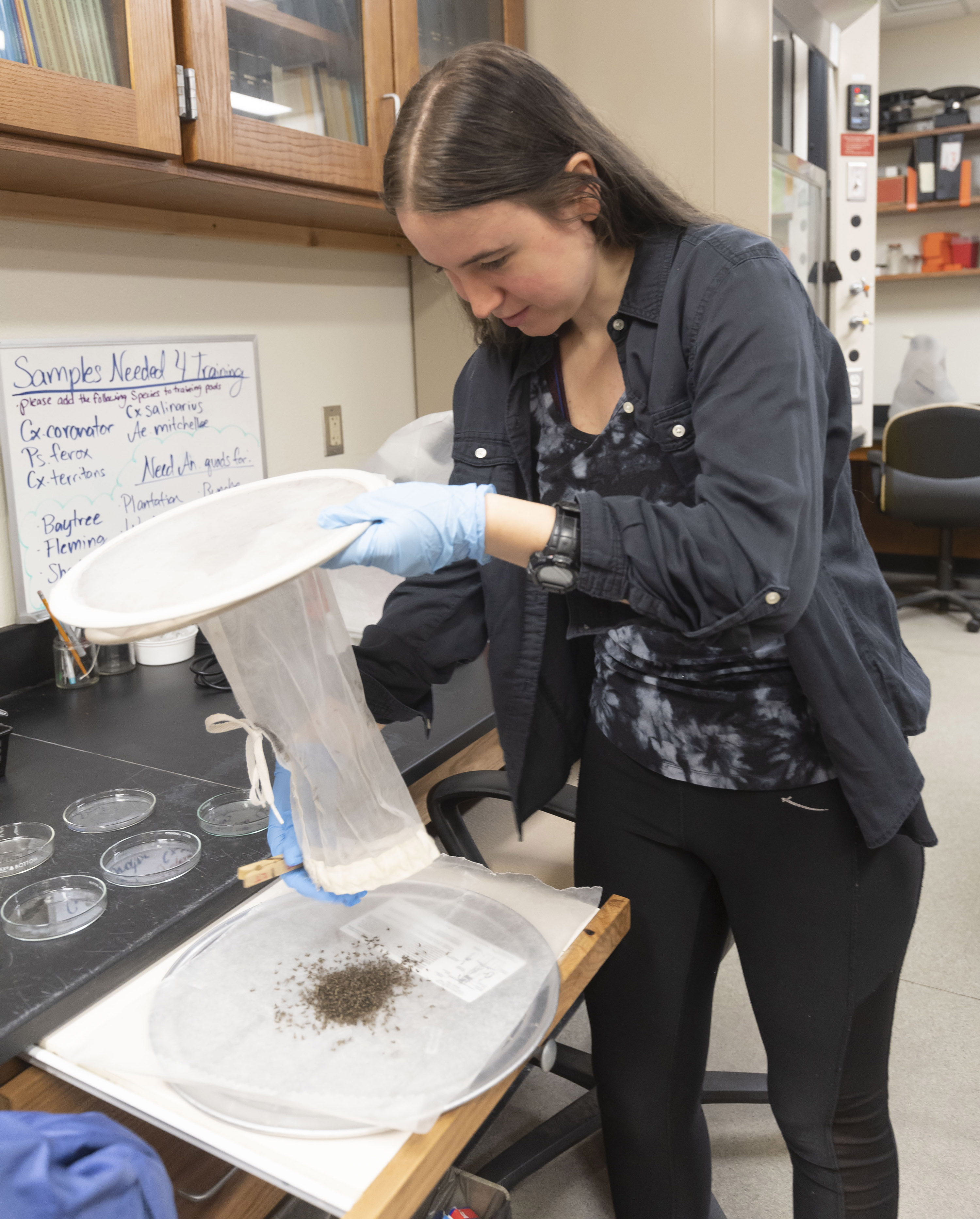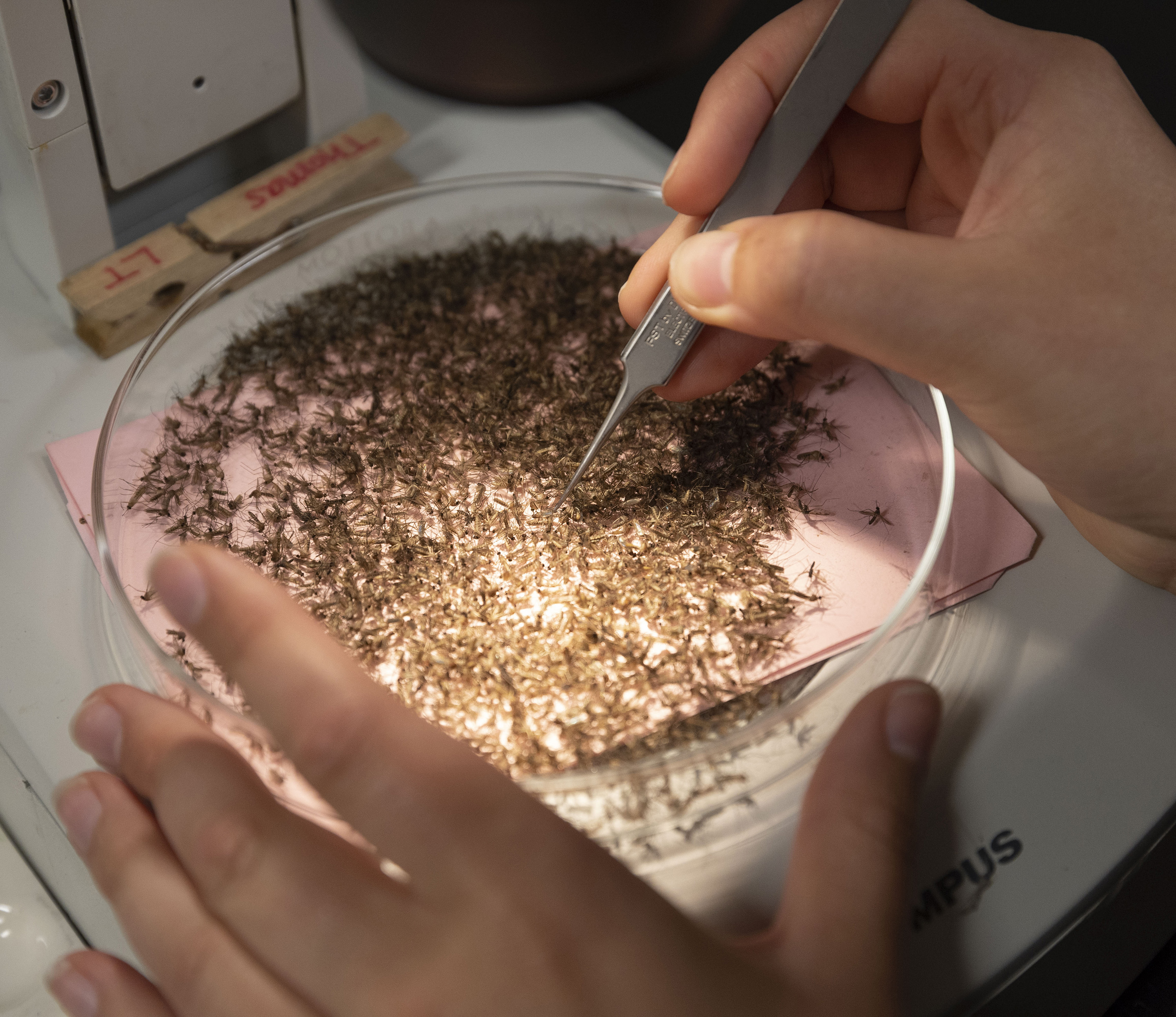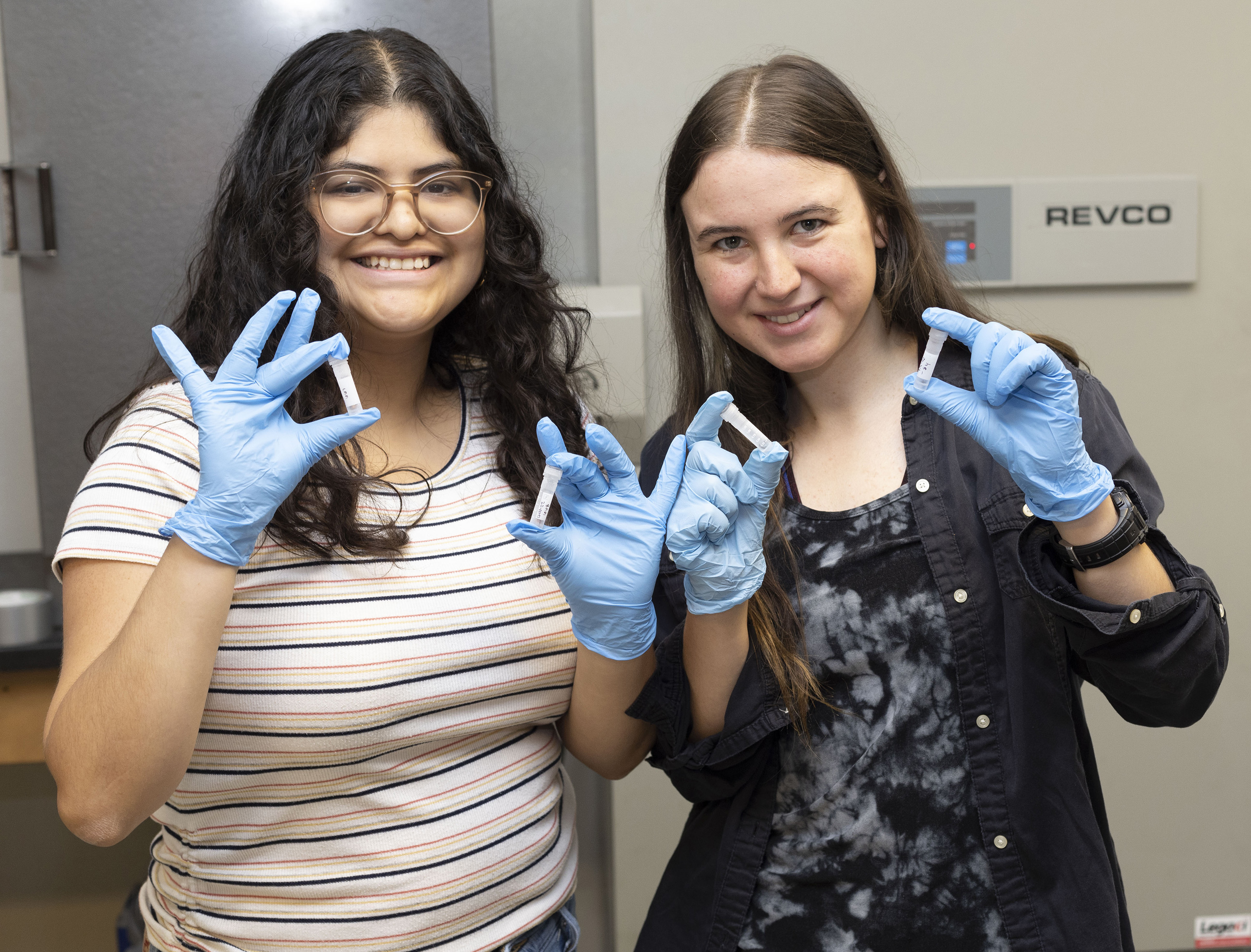August 3, 2022
22-103
Jessica Pope
Communications and Media Relations Coordinator
VSU Students Take the Lead on Area Mosquito Surveillance Program

|
|
Chloe Brevaldo, a nursing major from St. George, Georgia, joined the Mosquito Surveillance Program in October 2020. She enjoys sorting the mosquitoes and seeing how they look under the microscope. She hopes her work contributes to efforts locally and abroad to learn more about mosquito-borne diseases, like West Nile Virus.
|
VALDOSTA — A group of Valdosta State University student researchers have spent the past five months working to create new knowledge and potentially save lives. Their efforts will continue throughout the fall as they seek to support public health initiatives to protect area residents from mosquito-borne diseases.
More than two decades ago, VSU, the City of Valdosta, Lowndes County, and the Georgia Department of Public Health’s South Health District established a collaborative Mosquito Surveillance Program. It works by providing data on vector and virus activity to local, state, national, and international health agencies and researchers so precautions can be taken to help prevent disease transmission from mosquitoes to humans and animals.
Working under the guidance of Dr. Mark Blackmore, a professor in VSU’s Department of Biology, the student researchers collect mosquitoes using traps placed in strategically located, permanent sampling areas throughout Valdosta and Lowndes County. Traps are placed in the afternoons, and the mosquitoes are collected the following morning and taken to the Mosquito Surveillance Program lab on the second floor of VSU’s Hugh C. Bailey Science Center. This happens several times a week.
“We usually do collections from March through November, but for the past two years we have done some collecting in the winter months to better understand the biology of the species that are involved in West Nile Virus transmission,” Blackmore shared.
In the VSU lab, the mosquitoes are anesthetized to prevent movement. The student researchers examine them under a microscope and separate them into groups based on species.
Blackmore said there are roughly three dozen species of mosquitoes in the Valdosta-Lowndes County area.
The mosquitoes are then packaged and transported to the College of Veterinary Medicine at the University of Georgia where they are tested for mosquito-borne diseases.
The Mosquito Surveillance Program confirmed the area’s first West Nile Virus activity of the year in late June. The first Eastern Equine Encephalitis activity of the year was identified in mid-May.
The Mosquito Surveillance Program is the first program of its type in the region and one of the first in the state. Because the sampling sites never change, Blackmore said his research team is able to compare data from year to year and help guide public health initiatives — including mosquito control efforts — designed to promote health and safety in Valdosta and Lowndes County.
“Every year brings a new set of challenges and something new in what we learn about mosquito-borne diseases in this area,” he added. “Different weather patterns, drought, or flooding have big effects on mosquito populations and vary all the time. We have documented the arrival of two new mosquito species as they expanded their distribution in the southeast. We have documented the absence of one of the worst species — yellow fever mosquito — that once occurred in Valdosta but is not present now. Our data is used by state, national and even international researchers monitoring mosquitoes and mosquito-borne diseases.”
Through this experiential learning opportunity, Blackmore’s students gain a number of important skills, like data entry and data analysis. They learn how to identify mosquitoes to species and the techniques involved in preparing them for virus testing. He said the research skills they learn in his lab contribute to their ability to gain access to advanced training at medical and research programs across the country.
Chloe Brevaldo, a nursing major from St. George, Georgia, joined the Mosquito Surveillance Program in October 2020. She described the experience as “unique and educational.”
Brevaldo shared how she enjoys sorting the mosquitoes and seeing how they look under the microscope. “To be honest, some of the different species actually look pretty when enlarged,” she explained. She said the research team hopes their work contributes to efforts locally and abroad to learn more about mosquito-borne diseases, like West Nile Virus.
The Mosquito Surveillance Program has inspired several VSU students to continue their education in the field of biology, including one Blazer alum who went on to earn a doctorate while studying Zika Virus before joining the Florida Department of Health and another alum who is currently pursuing a doctorate and studying mosquitoes at the University of Georgia. Others have gone on to careers as physicians or veterinarians, Blackmore said.
Yasmin Guzman of Bainbridge, Georgia, plans to continue working in a research lab setting after graduating with her Bachelor of Science in Biology and Minor in Chemistry in December, before applying to medical school. She joined the Mosquito Surveillance Program team as a mosquito identification technician in August 2019 and currently serves as director of operations in the on-campus lab.
“My favorite part of the job is interacting with others,” she shared. “I have met many amazing students and staff throughout my time in the lab. It has been a pleasure to see everyone succeed in their goals outside of the lab.”
According to the American Mosquito Control Association, more than one million people worldwide die from mosquito-borne diseases each year. Mosquitoes also carry diseases that have the potential to cause suffering in dogs and horses, as well as other animals.
West Nile Virus and Eastern Equine Encephalitis are the two mosquito-borne diseases traditionally identified in the Valdosta-Lowndes County area each year.
“When we receive a positive result, it reminds us of how important mosquito surveillance is for the health of both our community and the animals of our county,” Guzman said.
Chris Calhoun, environmental health director for Public Health’s South Health District, stressed that the best protection against mosquito-borne diseases is avoiding a mosquito’s bite.
The Georgia Department of Public Health’s South Health District, which serves a 10-county region including Lowndes County, offered the following tips for preventing mosquito bites now through the fall:
• Use insect repellant containing DEET, picardin, IR3535, or oil of lemon eucalyptus on exposed skin and/or clothing.
• Wear long sleeves and pants whenever possible.
• Have secure, intact screens on windows and doors to keep mosquitoes out.
• Eliminate mosquito-breeding sites by emptying standing water from flowerpots, buckets, barrels, wading pools, and other containers and drilling holes in tire swings.
Peak mosquito-biting hours are between dusk and dawn.
On the Web:https://www.valdosta.edu/biology/
https://southhealthdistrict.com/
https://www.cdc.gov/westnile/index.html
https://www.cdc.gov/EasternEquineEncephalitis/
Newsroom
- Office of Communications Powell Hall West, Suite 1120
-
Mailing Address
1500 N. Patterson St.
Valdosta, GA 31698 - General VSU Information
- Phone: 229.333.5800
- Office of Communications
- Phone: 229.333.2163
- Phone: 229.333.5983
 More than two decades ago, VSU, the City of Valdosta, Lowndes County, and the Georgia Department of Public Health’s South Health District established a collaborative Mosquito Surveillance Program. It works by providing data on vector and virus activity to local, state, national, and international health agencies and researchers so precautions can be taken to help prevent disease transmission from mosquitoes to humans and animals.
More than two decades ago, VSU, the City of Valdosta, Lowndes County, and the Georgia Department of Public Health’s South Health District established a collaborative Mosquito Surveillance Program. It works by providing data on vector and virus activity to local, state, national, and international health agencies and researchers so precautions can be taken to help prevent disease transmission from mosquitoes to humans and animals. Yasmin Guzman of Bainbridge, Georgia, left, joined the Mosquito Surveillance Program team as a mosquito identification technician in August 2019 and currently serves as director of operations in the on-campus lab. She plans to continue working in a research lab setting after graduating with her Bachelor of Science in Biology and Minor in Chemistry in December, before applying to medical school.
Yasmin Guzman of Bainbridge, Georgia, left, joined the Mosquito Surveillance Program team as a mosquito identification technician in August 2019 and currently serves as director of operations in the on-campus lab. She plans to continue working in a research lab setting after graduating with her Bachelor of Science in Biology and Minor in Chemistry in December, before applying to medical school.